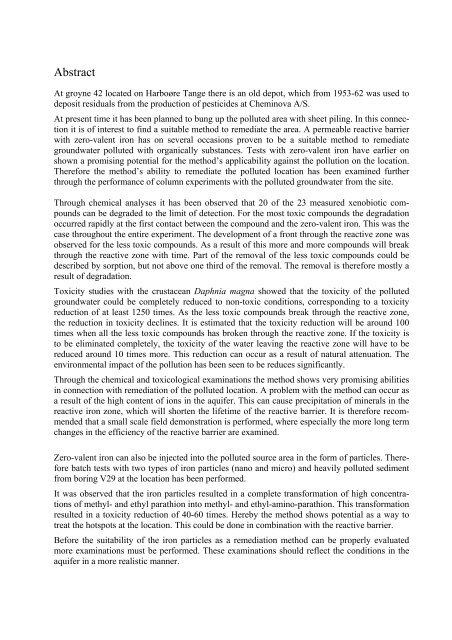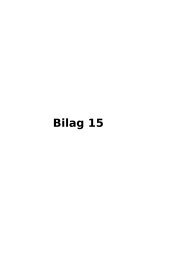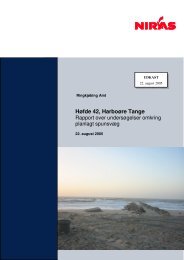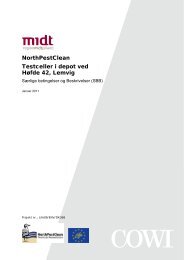2005-11-01. Evaluering af nul-valent jern til ... - NorthPestClean
2005-11-01. Evaluering af nul-valent jern til ... - NorthPestClean
2005-11-01. Evaluering af nul-valent jern til ... - NorthPestClean
You also want an ePaper? Increase the reach of your titles
YUMPU automatically turns print PDFs into web optimized ePapers that Google loves.
Abstract<br />
At groyne 42 located on Harboøre Tange there is an old depot, which from 1953-62 was used to<br />
deposit residuals from the production of pesticides at Cheminova A/S.<br />
At present time it has been planned to bung up the polluted area with sheet piling. In this connection<br />
it is of interest to find a suitable method to remediate the area. A permeable reactive barrier<br />
with zero-<strong>valent</strong> iron has on several occasions proven to be a suitable method to remediate<br />
groundwater polluted with organically substances. Tests with zero-<strong>valent</strong> iron have earlier on<br />
shown a promising potential for the method’s applicability against the pollution on the location.<br />
Therefore the method’s ability to remediate the polluted location has been examined further<br />
through the performance of column experiments with the polluted groundwater from the site.<br />
Through chemical analyses it has been observed that 20 of the 23 measured xenobiotic compounds<br />
can be degraded to the limit of detection. For the most toxic compounds the degradation<br />
occurred rapidly at the first contact between the compound and the zero-<strong>valent</strong> iron. This was the<br />
case throughout the entire experiment. The development of a front through the reactive zone was<br />
observed for the less toxic compounds. As a result of this more and more compounds will break<br />
through the reactive zone with time. Part of the removal of the less toxic compounds could be<br />
described by sorption, but not above one third of the removal. The removal is therefore mostly a<br />
result of degradation.<br />
Toxicity studies with the crustacean Daphnia magna showed that the toxicity of the polluted<br />
groundwater could be completely reduced to non-toxic conditions, corresponding to a toxicity<br />
reduction of at least 1250 times. As the less toxic compounds break through the reactive zone,<br />
the reduction in toxicity declines. It is estimated that the toxicity reduction will be around 100<br />
times when all the less toxic compounds has broken through the reactive zone. If the toxicity is<br />
to be eliminated completely, the toxicity of the water leaving the reactive zone will have to be<br />
reduced around 10 times more. This reduction can occur as a result of natural attenuation. The<br />
environmental impact of the pollution has been seen to be reduces significantly.<br />
Through the chemical and toxicological examinations the method shows very promising abilities<br />
in connection with remediation of the polluted location. A problem with the method can occur as<br />
a result of the high content of ions in the aquifer. This can cause precipitation of minerals in the<br />
reactive iron zone, which will shorten the lifetime of the reactive barrier. It is therefore recommended<br />
that a small scale field demonstration is performed, where especially the more long term<br />
changes in the efficiency of the reactive barrier are examined.<br />
Zero-<strong>valent</strong> iron can also be injected into the polluted source area in the form of particles. Therefore<br />
batch tests with two types of iron particles (nano and micro) and heavily polluted sediment<br />
from boring V29 at the location has been performed.<br />
It was observed that the iron particles resulted in a complete transformation of high concentrations<br />
of methyl- and ethyl parathion into methyl- and ethyl-amino-parathion. This transformation<br />
resulted in a toxicity reduction of 40-60 times. Hereby the method shows potential as a way to<br />
treat the hotspots at the location. This could be done in combination with the reactive barrier.<br />
Before the suitability of the iron particles as a remediation method can be properly evaluated<br />
more examinations must be performed. These examinations should reflect the conditions in the<br />
aquifer in a more realistic manner.





